
southern and coastal Peru, northwestern Bolivia, and northern Chile. The following text is
taken from their diaries, with truk's writing in a normal font and Katherine's in italic.
If you have an corrections or comments, please email them to us [truk@truk.com].
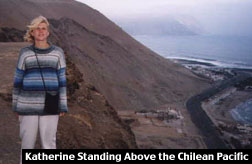 (ARICA and AREQUIPA; written in AREQUIPA).
Arica turned out to be pretty boring. As it was Sunday when we
arrived, nothing was open and even less was going on. Some soldiers
from the local base were milling around, sucking on ice cream
and making phone calls. We got a ride from the airport with a
nervous guy named Sabastian. He seemed nice enough but overly
concerned about what I did for a living.
(ARICA and AREQUIPA; written in AREQUIPA).
Arica turned out to be pretty boring. As it was Sunday when we
arrived, nothing was open and even less was going on. Some soldiers
from the local base were milling around, sucking on ice cream
and making phone calls. We got a ride from the airport with a
nervous guy named Sabastian. He seemed nice enough but overly
concerned about what I did for a living.
It is surprisingly cool here, albeit not as cold as the altiplano, but more damp and beachy. The city, which was overcast most of the afternoon, looks bleak with out the sun. I am a bit disappointed in this place. I suppose that I expect to see a difference between Peru, Bolivia, and Chile, but so far the the differences are the currency, the expense, and the fact that most toilets here have toilet seats and covers. That's about it. I'm sure further south in Chile is different...
Kath and I climbed the big sand hill in town (El Morro de
Arica) to get a view of the whole city. There, a big battle took
place between the Chileans and Peruvians in 1880. Pinochet put
up a big monument in 1980 to commemorate the event. Lame dioramas
with poorly painted toy solders seemed to seek to explain the
battle. From what I could gather, either the Peruvians were complete
morons or Pinochet hired a very good, imaginative revisionist
of history. My vote is for the latter. One thing 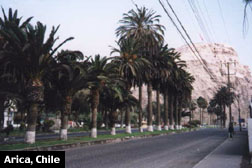 about
the area did not suck, however; the view from the top was spectacular.
The Pacific rolled toward us, and waves crashed with the force
of an angry sea throwing them toward the land. We wandered around
town after coming down off the hill, and Kath called home for
her dad's birthday. We ate at a nice restaurant we just stumbled
into and then returned to the room to drink the only liter-sized
bottle of Guinness I have ever encountered.
about
the area did not suck, however; the view from the top was spectacular.
The Pacific rolled toward us, and waves crashed with the force
of an angry sea throwing them toward the land. We wandered around
town after coming down off the hill, and Kath called home for
her dad's birthday. We ate at a nice restaurant we just stumbled
into and then returned to the room to drink the only liter-sized
bottle of Guinness I have ever encountered.
The next day, the 27th, we were on a collectivo (shared taxi)
heading for Tacna, Peru. This time, there were no border delays.
The guy took us straight to the bus station and we boarded one
for Arequipa. We got into town about six, found a decent hotel,
had some dinner at a slow pizza place, and walked around the
square. There was a big party going on, as Peruvian Independence
Day was the next day. On the 28th, we visited the Santa Catalina
Monastery. The place was built in 1580 and expanded during the
next century. The place is an amazing labyrinth of tiny streets
and well-restored cells. As the Catholic tradition dictates that
the second daughter of a household become a nun and this was
a pretty lavish place, the monastery became The Place for rich
girls to give their lives over to Christ. Many of the women had
two or more servants, and their parties, which included everything
from booze to the best music, were famous. Finally, news of this
reached the Pope in the mid-19th century and he send in a mother
superior who, from her pictures in the place definitely did not
like to rock-and-roll. 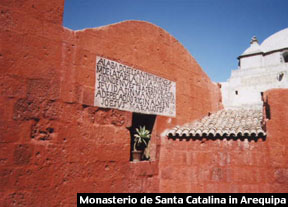 The high walls of
the complex, which takes up an entire city block, kept out the
world until 1970, when the mayor of the town forced the monastery
to install running water and electricity. The nuns were too broke
to do it, so they opened up the place to tourists and stayed
in one corner of the complex.
The high walls of
the complex, which takes up an entire city block, kept out the
world until 1970, when the mayor of the town forced the monastery
to install running water and electricity. The nuns were too broke
to do it, so they opened up the place to tourists and stayed
in one corner of the complex.
We made it all the way to Arequipa yesterday, after a crowded collectiveo to Tacna, 6 people in an old Dodge care and a driver who picked his nose... We arrived in Tacna just in time to get a 10:30 bus to Arequipa. Stacy hurriedly changed our pesos into Soles, an exchange that we lost money on, but it had to be done. We climbed through the sand dune hills, back toward Arequipa, back into an altitude of about 2200 meters (not too high)/ We arrived in Arequipa around 5:30 in the afternoon, just in time for the "Independence of Peru" activities. July 27-29 are independence festivals all around Peru. This is a fun time to be here. I think a little more expensive for the gringo visitor than at other times. We got a room at the Hostel Latino ($22) with a bath, televisions and a phone. The other places we had flagged in the Lonely Planet guide were either closed or complete dumps. Dropping our bags, we proceeded to search for food and played "chicken" with the crowded streets, bumper-to-bumper cars and wandering pedestrians. They have a Subway restaurant here, but is is expensive compared to the other food. We settled, out of hunger and fatigue, on a very mediocre pizza place. We went to an internet cafe and then walked the streets a bit. The Plaza de Armas was full of music and people and a festive atmosphere/ We listened to music and walked about. A little girl selling candy hounded Stacy until finally we walked out of "her territory." She left us with a "chow" and headed in the other direction.
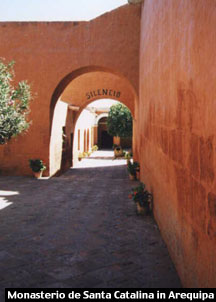 28 JULY, 1998 -
AREQUIPA, PERU -- Today is Peru's Independence Day. Last night
the festivities were partly for independence and partly celebrating
the fact that few people are working today. That means no lavenderia
(no clean laundry). As it ends up, though, the people who sold
us our 2 day tour to Colca Canyon have a "particular"
lavenderia that they know is open. We left our clothes with them
and inquired about night buses to Nazca. The tour company quoted
us 55 soles each, so naturally, we went straight to the bus company
and got them for much less. We spent the rest of the day visiting
sites around town. First, the Monastery of Santa Catalina. A
pretty cool place. The nuns were cloistered, coming to the monestary
as the second daughter of some of the most well-to-do families,
bringing their servants and their lifestyles with them. The "fun"
cloistered life lasted until the Big Bad Sister Superior was
sent by the Pope to get them straightened out. The Pope had gotten
some complaints that the sisters of Santa Catalina were not living
up to their ascetic vows. Sister Superior set all of the servants
free and changed the social life to a monastic life - the kind
typically associated with celebacy and cloistering. The colors
of the various areas were a beautiful contrast to the cold, small
quarters - the doorways into most of the formerly private spaces
were less than 5 feet high. The curves of the archways, the shadows
the sun throws on the courtyards, and the coolness of the cells
made for a peaceful visit. I bought some parsley soap - one of
the items the few remaining nuns (20) make and sell to the public.
28 JULY, 1998 -
AREQUIPA, PERU -- Today is Peru's Independence Day. Last night
the festivities were partly for independence and partly celebrating
the fact that few people are working today. That means no lavenderia
(no clean laundry). As it ends up, though, the people who sold
us our 2 day tour to Colca Canyon have a "particular"
lavenderia that they know is open. We left our clothes with them
and inquired about night buses to Nazca. The tour company quoted
us 55 soles each, so naturally, we went straight to the bus company
and got them for much less. We spent the rest of the day visiting
sites around town. First, the Monastery of Santa Catalina. A
pretty cool place. The nuns were cloistered, coming to the monestary
as the second daughter of some of the most well-to-do families,
bringing their servants and their lifestyles with them. The "fun"
cloistered life lasted until the Big Bad Sister Superior was
sent by the Pope to get them straightened out. The Pope had gotten
some complaints that the sisters of Santa Catalina were not living
up to their ascetic vows. Sister Superior set all of the servants
free and changed the social life to a monastic life - the kind
typically associated with celebacy and cloistering. The colors
of the various areas were a beautiful contrast to the cold, small
quarters - the doorways into most of the formerly private spaces
were less than 5 feet high. The curves of the archways, the shadows
the sun throws on the courtyards, and the coolness of the cells
made for a peaceful visit. I bought some parsley soap - one of
the items the few remaining nuns (20) make and sell to the public.
After the long haul down San Juan de Dios (to find the bus company), we went to the San Francisco Monastery. A very different place from the Santa Catalina . This monestary is no longer inhabited by priets. Today, it is a museum with museums within it. There was a small, but representative collection of pottery, stoneware, and skeletal remains from all over Peru, some pre-Incan and all pre-Colonial artifacts. Material culture collected during the Franciscans missions into Peru to collect "Christian souls." There was also an interesting collection of Amazonian items, interesting probably only because I have not been exposed to that side of Peru on this journey. There were stuffed animals - birds, snakes, monkeys, alligators- clothes from the Amazonian region and more. Of course there was a room for religious art and an area of the monastery preserved from the operational years. Additionaly, the library at the monastery (more like archives) had books dating back to 1462 and 1469.
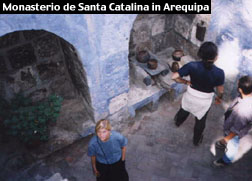 We ambled back to
the Plaza de Armas for a cup of tea and them home for a siesta,
but were sidetracked by Hugo and Diane, a couple from the northeast
US (New York and Connecticut, respectively) looking for someone
who spoke English to take their picture. They were traveling
for a month, in kind of an opposite route to our journey. We
decided to meet for diner at the vegetarian restaurant. Hugo
is Argentian and speaks fluent Spanish, which was really nice
for us - the level of treatment for a fluent Spanish speaker
is completely different than for someone just struggling to get
by with the basics. We decided to go have a beer some place,
thinking that since it was Peru's Independence Day, surely there
is a celebration going on somewhere - not a chance. Many places
were closed for the holiday. The few bars open were either filled
with people and bad , loud American music or were charging a
ridiculous cover to get in. We ended up at a pizza place over
a beer and talked until midnight when we said goodnight. Stacy
and I headed back to the Wilson, which was still pretty deserted
when we returned, save the guy who came to the door. I think
he was waiting up for us.
We ambled back to
the Plaza de Armas for a cup of tea and them home for a siesta,
but were sidetracked by Hugo and Diane, a couple from the northeast
US (New York and Connecticut, respectively) looking for someone
who spoke English to take their picture. They were traveling
for a month, in kind of an opposite route to our journey. We
decided to meet for diner at the vegetarian restaurant. Hugo
is Argentian and speaks fluent Spanish, which was really nice
for us - the level of treatment for a fluent Spanish speaker
is completely different than for someone just struggling to get
by with the basics. We decided to go have a beer some place,
thinking that since it was Peru's Independence Day, surely there
is a celebration going on somewhere - not a chance. Many places
were closed for the holiday. The few bars open were either filled
with people and bad , loud American music or were charging a
ridiculous cover to get in. We ended up at a pizza place over
a beer and talked until midnight when we said goodnight. Stacy
and I headed back to the Wilson, which was still pretty deserted
when we returned, save the guy who came to the door. I think
he was waiting up for us.
Afterward, we booked a tour to the Colca Canyon, this supposedly incredible place just north of here, and located a vegetarian restaurant. In the afternoon, we bought a ticket to Nazca and visited the Recoleta Museum, which is collection of artifacts, stuffed jungle creations, extremely old books (one from 1494) that the Franciscan brothers collected while indoctrinating the natives into a Christian lifestyle. Once, we got back to the hotel, we met some kind folks from the northeast US, Hugo and Diane, who we will have dinner with tonight.
La Paz -> Arequipa -> Colca Canyon -> Nazca/Pisco/Lima